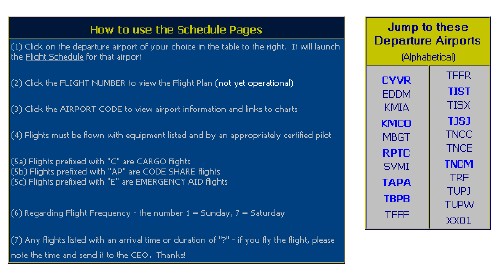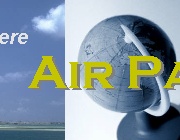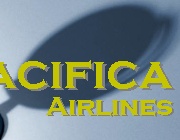=1=
Navigating the Flight Schedule If
you are wanting to fly a flight for "official"
recognition with Air Pacifica, you need to pick a flight from
our Flight
Schedules (currently offline). These are the officially
recognized flights for the airline, and are constantly being
updated, added, modified, etc. So it is important that
you make regular checks of the schedule before flying your
"official" flights (ones that you want to count
towards your pilot hours and career at Air Pacifica). Visit
the Flight
Schedules (currently
offline) page, and read through the section on
How to use the Schedule Pages. This will help
familiarize yourself with what to expect. (Picture
below) 
Next,
using the yellow/grey table at the right, you are going to
want to click on the Airport Code for Cyril E. King
airport - which happens to be
TIST.
Scrolling down this list of available departure flights, you
will find one highlighted in GREEN. 
You'll
want to make note of Flight #1118, so that you can keep
your flight as "real" as you want to. As you
can see, the flight is set to depart at 11:00am, and is
due to arrive at Beef Island at 11:25am. It runs
every day of the week, and has been assigned the PA-28
aircraft. Just right
for you! Also, it is
always a good idea to click on the Airport Codes on
this schedule page (click on these links for TIST
and
TUPJ), to find out exact
information about the airports, runways, and frequencies that
may assist you during your flight. The important
information that you will want from these two airport
information screens are:
- The ATIS frequency for
Cyril E. King - 124.00
- The runway heading at Beef
Island - RWY 07 - 073° / RWY 25 - 253°
- The runway length at Beef
Island - 3599ft (lots of room for the Piper)
- NOTAMs for your departure
and arrival airports - Watch for Terrain on departure
at TIST, and on arrival at TUPJ
- Is your arrival airport
equipped with ILS runways - No - Beef Island is VFR
only
=2=
Finding Your Starting Position
So now that we have the flight
information, you can now start up FS, and load your Saved
Flight Position at Cyril E. King airport. This
should have been done during "What you Need : Step
#6", if you have been doing these lessons in
order. If not, jump
to that page now (currently offline), and get your flight setup at
the terminal at Cyril E King airport. The
last thing you can do for extra "realism", is set
your World | Time & Season, to be 15 minutes prior
to the scheduled departure time - in the case of Flight #1118,
you would set your flight time to be 10:45AM - day of
the week, and time of year is entirely up to you.
=3= Preparing for
Departure
Okay, you've got the aircraft
loaded, you're at the Cyril E. King terminal, and you're in Cockpit
View. Get out your pen and paper and start making
your flight notes:
- Date of the flight
- Wind speed and direction
(tune COM1 frequency to 124.00 for ATIS
information)
- Altimeter Setting (again
from ATIS information) - Set by pressing "B"
key
- Suggested Departure Runway
("runway in use" from ATIS information)
Also, ensure you have your
fuel tanks filled, and that your controls are working
(joystick or keyboard). When you're ready to start the
engines, make note of the flight time. This will
be needed when you fill out the Flight Report Form.
=4= Departure, Cruise,
Navigation, Approach
Using due caution, you can
taxi your aircraft to the runway of your choice - taking note
of wind direction and speed as reported by the Airport's
ATIS Frequency (124.00 for TIST). You should NEVER
depart an airport under adverse conditions. If the wind
is too strong, or if it is a strong cross-wind, and there are
no alternative runways that are suitable - DON'T MAKE THE
FLIGHT. Your safety and that of your passengers is your
TOP PRIORITY. The route
for this flight is quite simple. Based on the departure
information standard for RWY 10 at Cyril E. King - all
aircraft are required to make an immediate direction change to
heading 120 after takeoff - to avoid terrain at the end
of RWY 28. This works great for us, because after flying
7 nm on a heading of 120, we can make a left turn to
heading 75 and be nearly perfectly aligned for a visual
approach to RWY 07 at Beef Island airport. So
startup, get taxiing to the runway suggested (which at St.
Thomas is almost always RWY 10 due to prevailing winds
direction) - and take off. Start your climb to 1,500 ft
and turn right to 120 when you're off the ground and in
stable flight. We know
to be at 1,500 ft for this flight because in
the Northern Hemisphere:
- all Eastbound flights fly
at ODD Altitudes in thousands of feet
- all VFR flights fly at +500
ft
- and since this is a short
flight, and we want to take in some scenery, 1,500 ft
makes good sense
Assuming you have some flight
planning software, you'll know when to make your left turn
to heading 075, but if not, with the power set to about
75% on the Piper, and climbing to 1,500 ft at 600 feet per
minute, when you level off at 1,500 ft - you're half way to
your turn point. About another 3 minutes (5-6
minutes from takeoff), and you're ready to turn towards Beef
Island airport.
On your way to Beef Island,
you'll pass over a number of small islands with hills.
Total cruise time should be about 8-10 minutes (assuming
you're doing about 110 knots and 75% power). Standard
speed restrictions for ALL aircraft below 10,000 ft is 250
knots. Our Piper doesn't come close to that speed,
so you don't have to worry about it now - but remember that
jewel of advice for later flights. Especially when
online - Air Traffic Controllers (ATCs) really hate it when
you speed below 10,000 ft.
As you begin your final
descent (about 3-4 miles out from runway 07), the important
thing to remember, is that there are terrain warnings
for the approach to runway 07 (our target runway for this
flight). You'll want to be flying the final approach by
hand - so that you can avoid the terrain, and make your final
drop into the runway after clearing the hills. It's not
a bad approach in the little Piper, but it does get more
interesting when you try putting larger aircraft like the De
Havilland DHC-6 down on the runway =)
=4= Landing Your Plane
The important thing to
remember, is gentle controls and slight adjustments go
a long way to ensuring a safe and comfortable landing for your
passengers. We're not trying to get the plane down as
fast as possible - we want it to touch down without the
passengers even noticing (well, okay - maybe too much to
ask!). Landing lights on! (CTRL - "L") NOTE:
Always remember to press the "B" key again, when
you're on final approach to any runway, to ensure that your
altimeter is properly set for your arrival runway. Your
altimeter tells you how far off the ground you are - having it
incorrectly set can have you belly land hard on the runway, or
overshoot the runway - either way big time annoyance =) Remember
to set your flaps - 1 or 2 notches as you approach the runway,
and cut back that speed so you're sitting at about 60-70 knots
- (Hopefully you read up on the aircraft specs to know the
stall speed and operating limits - right?) - and press the
"B" key to reset that altimeter. As
you pass over the end of runway 07, you should be no more than
50 feet off the runway, and should have your flaps to full
or full minus 1. Cut the throttle, and keep the
aircraft aligned to the runway and slightly nose up so it glides
down to a gentle landing on the runway. You may
start to get a Stall Warning, just as you are about to
touch down - don't worry about it, just keep slight gentle
back pressure on the stick so your back wheels touch first
(not so much to be pointing your aircraft to the sky mind
you!). Once you've got
all wheels down on the runway, start to apply brakes to slow
you down (NOT parking brakes, but just the period key brakes
"."). Once your speed is under 20 knots, you
can exit the runway on the first available taxiway, and make
your way to the parking area in front of the main terminals.
(Standard taxi speeds are <25 kts on taxiways, <15 kts
on the terminal apron). Landing lights OFF (CTRL -
"L").
=5= Parking at the
Terminal and Shutting Down
Once you taxi to the terminal,
and find an appropriate parking space near to it, set your Parking
Brakes ON, and go through the following checklist:
- Parking Brakes ON (CTRL -
".")
- Flaps retracted
("F5")
- Engine off / fuel flow off
(CTRL-SHIFT - "F1")
- All external lights off
(strobes, beacons, nav lights, taxi lights, landing
lights)
- Shutdown time noted for
Flight Log
Depending on the complexity of
the aircraft, you may have other things that need to be turned
off, but for this aircraft, the list should suffice.
=6= Filing your Flight
Report Online Now,
with your flight notes in hand, you can shut down FS, and head
to our website and the Online
Flight Report Form. When you visit this page on
our website, you will see a link to "Jump to the
Form", use this to get right to the top of the form. 
It
is pretty straight forward. Everything in RED
is required, the rest is only if you want to. For ease
of use, the list below contains everything that you are
probably going to select for your flight. Again change
the values to reflect YOUR flight data - this is just a
sample flight log entry:
- Your Pilot Number: APA492
- Full Email Address: ceo.airpacifica@peggware.com
- Date of Flight: 06-May-2001
- Flight Number: 1118
- Type of Flight: Passenger
- Aircraft Type: PA-28
Trainer
- Departure Aiport ICAO: TIST
- Arrival Airport ICAO: TUPJ
- Time at Pushback: 10:55
- Time at Shutdown: 11:20
- Total Flight Time: 0.4
- Approach Type: VFR
- Flight was Flown: OFFLINE
- Simulator Used: FS98
One of the important things to
remember, is that you must log your flight time in decimal
hours, not in hours and minutes. We include a handy
conversion chart on the Flight Report Form page, to let you
know what your minutes converts into as a decimal hour (i.e. 6
minutes = 0.1 decimal hours).
=6= Filing your Flight
Report Online
At this point, you've
successfully (a) downloaded one of our fleet aircraft, (b)
configured your FS program for a default position at St.
Thomas, (c) flown your first official flight, and (d) logged
your first Flight Report.
Many pilots just continue on
their own at this point, logging more flights, and increasing
their time flown, so that they can take Category Certification
Exams in our Training
Center (currently offline), and move up to bigger and more complex
aircraft. You do NOT have to continue to the next lesson
- and some of you won't be able to because of internet access
limitations, or software/hardware limitations.
However, increasingly there
are a number of pilots who take this whole flight simming
thing a step further, and enter the realm of Real-time
Online Multiplayer ATC Controlled Flight. A big
mouthful? It is - when you're new - but click on the
link below and you can be well on your way to flying more
"real" than you ever have before!
===> Next Stop:
Getting Online (currently offline)
|







